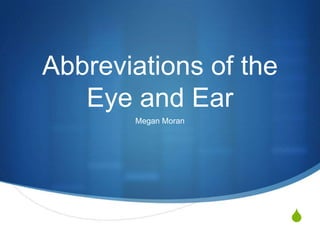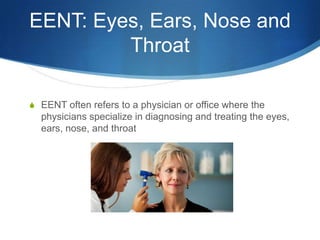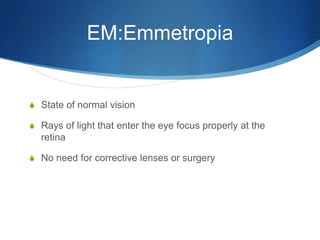Abbreviations of the Ear and Eye
- 1. Abbreviations of the Eye and Ear Megan Moran S
- 2. PE Tube: Pressure Equalizing Tube S Small tube S Surgically implanted into child’s eardrum to assist in draining trapped fluid S Equalizes pressure between middle ear and outside atmosphere
- 3. EENT: Eyes, Ears, Nose and Throat S EENT often refers to a physician or office where the physicians specialize in diagnosing and treating the eyes, ears, nose, and throat
- 4. BC: Bone Conduction S Bone conduction is the conduction of sound to the inner ear through the bones of the ear S 3 ear bones: S Malleus S Incus S Stapes S BC is why people’s voices sound differently recorded than when they hear themselves talk S The skull conducts better at lower frequencies than air S People usually perceive their voice to be lower and fuller
- 6. OM: Otitis Media S Middle Ear Infection/ Inflammation S Commonly seen in children S Fluid accumulation in the ear cavity that may be watery or full of pus S Symptoms Include: fever, Normal Middle Ear VS. Infected Middle Ear ear pain, and a feeling of fullness in the ear
- 7. EM:Emmetropia S State of normal vision S Rays of light that enter the eye focus properly at the retina S No need for corrective lenses or surgery
- 8. XT: Extropia S Outward turns outward due to muscle weakness S Also called wall-eyed S Opposite of cross- eyed Extropia of the Left Eye
- 9. OS: Left Eye
- 10. EOM: Extraocular Movement S Eye movements controlled by muscles innervated by cranial nerves III, IV and VI. S Testing these eye movements looks for damage to the nerves S Most common symptom from damage is double vision
- 11. VA: Visual Acuity S The measurement of the sharpness of vision S Tested by using a Snellen chart S Patient stands 20 feet away from chart and indentifies letters from that distance
- 12. References S Fremgen, Bonnie F., and Suzanne S. Frucht. Medical Terminology: A Living Language. Upper Saddle River, NJ: Pearson Prentice Hall, 2009. Print. S http://www.medicinenet.com/ear_infection/article.htm S http://www.neuroexam.com/neuroexam/content.php?p=2 0











